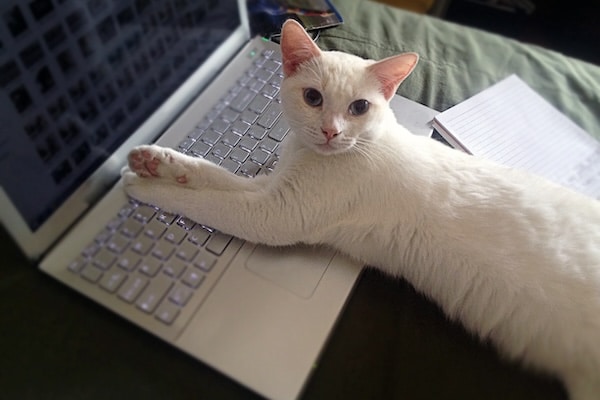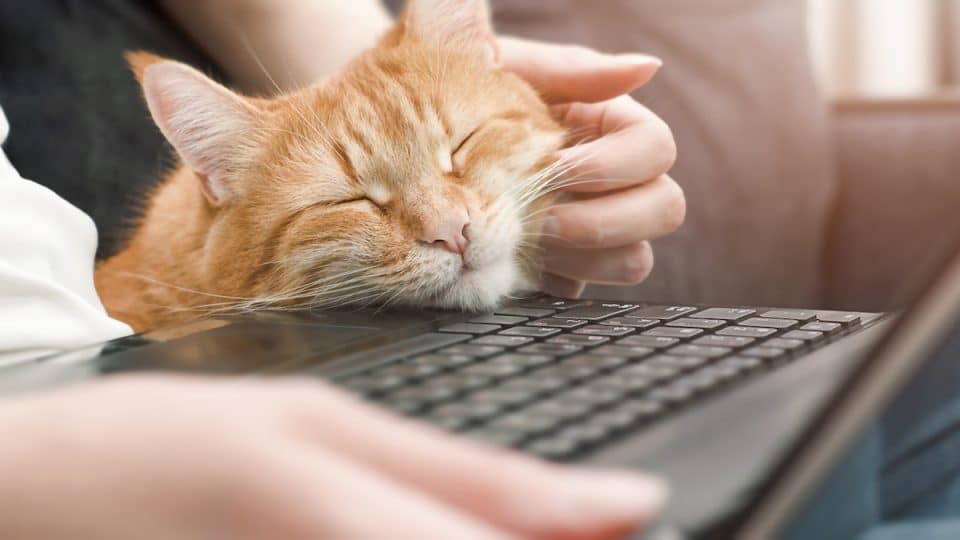Cats are wonderful companions—but working at home with them comes with some challenges. While there’s plenty of joy to be had in a chatty kitty sprawling out on a keyboard or demanding playtime while you’re on the clock, it can also make it hard to be productive.
Sure, knowing how to distract a cat will work in a pinch. But the secret to long-term success is something more basic, according to Joey Lusvardi, certified cat behavior consultant and founder of Class Act Cats. The goal is to meet your cat’s needs, which means establishing a routine, setting up cat-friendly spaces, and offering lots of enrichment.
Why Is My Cat Bothering Me While I’m Working From Home?
The occasional visit from your kitty during the workday is one of the perks of working from home—but if requests for pets or play are constant, it can be difficult to get things done.
There are a range of reasons your cat might be pestering you while you’re working:
- Your cat’s needs aren’t all being met
- You’ve reinforced your cat’s behavior
- Your cat has separation anxiety
Your cat’s needs include mental and physical enrichment—which means increasing regularly scheduled playtime and sprucing up their environment might be in order.
It’s also possible that you’ve inadvertently rewarded your cat’s attention seeking. Lusvardi explains that responding to your cat while they’re yowling at you, even if you’re telling them to stop, is rewarding them with a reaction.
If you’ve got a very clingy kitty, separation anxiety might be the problem. While separation anxiety in cats hasn’t been extensively studied, Lusvardi says the biggest red flag that is that the kitty in question will continue to vocalize and act distressed even if you’re completely gone from the home, not just when you’re in a separate room.
“A security camera is a great way to tell if this is happening,” Lusvardi advises.

Molina86 via iStock
Create a Good Work and Cat Schedule
For most lovingly pestering cats, the key to a good work from home relationship is a predictable schedule.
“Cats thrive with predictability and consistency,” Lusvardi says. They’re also very good at picking up patterns. Sticking to the same mealtimes and playtimes can lead to a calmer kitty who is less likely to crash your next Zoom meeting.
“They’ll learn over time that they don’t need to worry about not getting fed or getting attention from their favorite humans because it’s going to be coming eventually,” Lusvardi explains.
Sample WFH schedule
If you’re working a traditional nine-to-five shift, try this work-from-home-with-cats routine:
- 7:00 AM: Wake up and get ready
- 7:30 AM: Playtime with your cat
- 7:45 AM: Breakfast for you and your cat
- 7:55 AM: Set out an enrichment item for your cat, like cardboard boxes, cat tunnels, or paper bags
- 8:00 AM: Start working
- 12:00 PM: Lunch break with a small play and petting session with your cat
- 12:30 PM: Return to work, set out different enrichment item or activity for your cat
- 5:00 PM: End of your work day
- 5:15 PM: Playtime, petting, or other bonding activity followed by dinner for your cat
If you’re working unconventional hours, like on another country’s time zone, Lusvardi suggests adding automatic feeders and getting a wand toy you can easily manipulate with one hand to sneak in playtime with your cat during the last part of your shift so you can go right to bed!
Set Up Cat Spaces
The ideal work-from-home setup for cats has several acceptable places for your cat to climb, lounge, and hang out near you. “Make sure wherever you don’t want them to go has a more appealing alternative,” Lusvardi suggests.
For instance, a cat tree, cat shelves, or desk and window perches can keep your high-climbing kitty’s paws off and away from your work.
Lusvardi says you can even take it a step further: “Consider giving your cat their own office setup!” For chair-thieving and keyboard-napping felines, consider repurposing an old office chair and a defunct laptop you’d otherwise recycle. Giving your kitty a typically off-limits hot spot can keep them away from the ones you need to use.
Having numerous outlets for mental stimulation in your workspaces is also a way to keep your kitty calm and entertained.
“This doesn’t always mean playing with toys. It might mean enjoying sitting in a paper bag or checking out some cat grass,” Amanda Caron, a cat behaviorist and founder of Frisky Feline Behavior Counseling says. “Rotate what you offer to your cat, because life gets boring for our cats too!”
Finally, remember to cat-proof your workspace, since most cats know nothing gets a human’s attention faster than destruction. In particular, get a cord protector and organizer to prevent nibbles on cables and wires.
How To Distract Your Cat
Even if you’ve got a stellar routine with physical and mental stimulation and meals at the same time each day, it’s still a good idea to have some distractions up your sleeves.
Electronic toys like lasers, mice on wheels, and tablet games with a child-safe case are quick options to distract your cat.
However, Lusvardi suggests cat caregivers use caution with relying on these types of toys. They work best when they supplement interactive play, not replace it.
Depending on what your job involves, multitasking and subtly adding in play is an option.
“I often will talk with clients while bouncing a toy like the Cat Dancer for my cats with one of my hands. The toy will keep bouncing a little bit even after you stop actively moving it, so your cat will be drawn in to try to catch it. As they hit the toy, the bouncing will continue,” Lusvardi says.
Rover’s own resident cat behavior expert Dr. Mikel Maria Delgado’s comprehensive guidebook Play With Your Cat! can help with more ideas!

m-gucci via iStock
Troubleshooting Common Work-From-Home Cat Problems
Sometimes things won’t, or don’t, go according to plan. If things go awry as you strive to work productively from home with your cat, remember—things go sideways in physical offices, too.
Anticipating and preparing for your cat’s needs before a big meeting, and being prepared for unforeseen events, can go a long way in staying on track throughout the day!
How can I get my cat off my keyboard?
One popular answer to this common work-from-home frustration is as simple as giving your cat their own laptop.
“A decoy laptop works surprisingly well. Often you just set them out and your cat will be drawn in to nap on the fake laptop that doesn’t have a functioning keyboard instead of your real laptop,” Lusvardi says.
This laptop trap isn’t really fooling your cat—it’s just a way to redirect your cat to a more appropriate outlet for their unwanted behavior.
If you don’t have an old laptop, you can buy a cheap cat-specific model, ranging from foam and fabric catnip-infused cat laptop toys to laptop-shaped cardboard scratchers.
You can also get an acrylic keyboard shield or repurpose a laptop stand to function as a keyboard shield, Lusvardi says. It works with his sassy Siamese cat, Poutine!
How can I stop my cat meowing during meetings?
If you have a very vocal kitty who insists on chiming in during your phone calls and virtual meetings, Lusvardi says the key is preparation and prevention.
“Try to figure out what they want from you and meet that need ahead of important calls,” Lusvardi advises. “You can’t expect them to just sit silently all day if they don’t have anything stimulating to do.”
Here are four suggestions to reduce your cat’s meowing during calls:
- Set up something more entertaining or appealing in another room to encourage your cat to spend time there instead of your office.
- Make sure your cat is fed and play with them for 5 to 10 minutes before your call.
- If you have to lock your cat out, keep your schedule consistent so they develop a routine for when the door stays shut and feel less distressed.
- Give your cat something to do while they’re in the room with you. That might be a food puzzle, a solo play toy, or cat games on a tablet.
How can I redirect an attention-seeking cat?
Sometimes it’s easy to confuse typical cat behaviors with attention-seeking ones. Caron says the key here is finding out the why that is motivating your kitty to disrupt your work-from-home day.
“Climbing on your office bookshelves or on your desk chair might actually not have anything to do with you but more so a desire for high places,” Caron says.
Accepting this natural behavior and setting up an alternative like an elevated cat bed above your desk gives your enthusiastic climber a more appropriate, more appealing, and less distracting high place to perch and lounge.
For young or high-energy cats, keeping toys handy for sudden cases of the zoomies is a positive way to meet their needs. “Automatic toys, especially those that have motion sensors, can be a great tool for self-redirection,” Caron says.
For food-motivated kitties, Caron suggests treat toys like the Hunting Feeder Mice Toys that can be filled ahead of time and stored in a container by your desk so you can quickly grab them.



